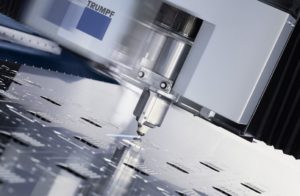 The use of laser technologies in the processing of materials is extremely diverse. Laser cutting of metal is the most common type of laser treatment.
The use of laser technologies in the processing of materials is extremely diverse. Laser cutting of metal is the most common type of laser treatment.
In the course of laser cutting, melting, evaporation of the metal and removal of molten particles from the cutting zone occurs by purging with process gas: air, nitrogen, oxygen or other process gas.
The main advantages of laser cutting: high quality of the technological process, speed, flexibility, minimum material costs because the width of the cut is only 0.1-0.2 mm.
When cutting with a laser, there is no need to mechanically fix the workpiece, since there are no significant mechanical loads on the workpiece, cutting is carried out by focused radiation.
Laser Cutting Technology
Laser engraving on paste with low power lasers is performed on the surface of metals using special pastes and is, in fact, some analog of thermal printing. Lasers sinter the paste and, as it were, weld it to the metal and ensure a high adhesion of the coating on the surface of the metal.
Laser marking or cutting is performed, as a rule, on metallic materials by pulsed lasers. The basic principle is all the same: achieve the change in the structure of the material’s surface by the action of a laser pulse. It is distinguished by its durability, high quality, and resistance to external influences in comparison with other traditional types of markings.
Execution of volumetric images in an optically transparent material, for example, glass, occurs by focusing radiation in the thickness of the material, and not on its surface, as in the case of laser marking. At the point of focusing, the structure changes, the material melts, or even a microexplosion – this changes the homogeneity of the material. Thus, one of the pixels constituting the image is formed.
This is only a small part of the applications of laser technologies, which are continuously involved in the production process, including the production of products for advertising.
Laser Cutting Opportunities
One of the directions of development of laser technologies which is on the verge of production and art is laser engraving. A wide range of laser engraving is known mainly as one of the types of preparation of gift items, however, its production capacity allows to create more sophisticated products.
For carrying out laser engraving, use a solid-state or gas CO2-laser. Both painted and nickel-plated metals are generally suitable for engraving. Depending on the complexity of the engraving job it can be reproduced as one piece, or a large print, such as curtains or office furniture. One of the directions of development of laser engraving is associated with the use of programming, although today it is quite costly.
In addition to engraving, there is a “voltron” or “laser sublimation” technique. If by means of engraving it is possible to reproduce graphic figures, the voltron allows transferring full-color images to the metal. It can be photos, diplomas, certificates and much more. The technique is different from standard engraving since with the help of the laser high-resolution images are produced. Such images are of good quality and transmit the slightest color nuances.
Cutting Metal
Now the sheet metal machine industry uses several methods of cutting metals. The most ancient and most common are acetylene-oxygen and plasma cutting, cheap at cost and “centuries-old technology”, but not environmentally friendly and no longer meet the increased requirements of the industry for accuracy.
A more accurate method – EDM cutting allows a cut with low metal losses (narrow cut), but is characterized by very low productivity. Recently, in order to save resources, reduce costs and material consumption of products, ever higher requirements are imposed on methods of processing metals, including the methods of cutting them.
Naturally, in this area machines and whole technological lines began to be used, where the main role is dedicated to the laser. These machines combine very high performance, both in terms of productivity, and in the accuracy and quality of the cut surfaces.
Due to the ease of controlling the laser beam, it becomes very easy to cut out complex parts of sheet metal up to 25 mm thick, as well as volume parts and blanks with a high degree of process automation.
The most effective is the use of a laser cutting machine in conditions of declining serial production if a rapid program change is necessary since the plant is easy to automate the process.
Currently, laser cutting machines based on solid-state lasers and gas lasers based on carbon dioxide are used for cutting metals. Of course, the cost of laser cutting equipment is quite high. But due to its accuracy, ease of rebuilding for one or another workpiece, as well as the possibility of using in areas where traditional approaches lead to significant difficulties or are simply impossible – laser cutting is a promising production.
Thank you for reading our articles, stay informed about the industrial world and Exapro by following us on Exapro Hub, Facebook, Twitter, and LinkedIn.



